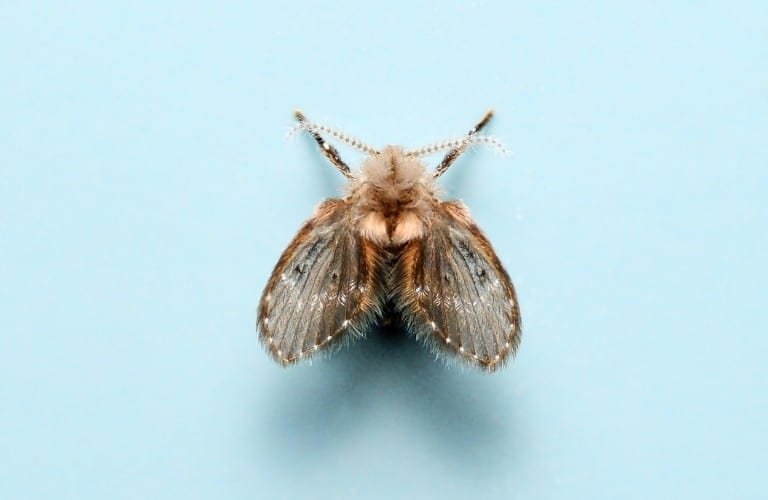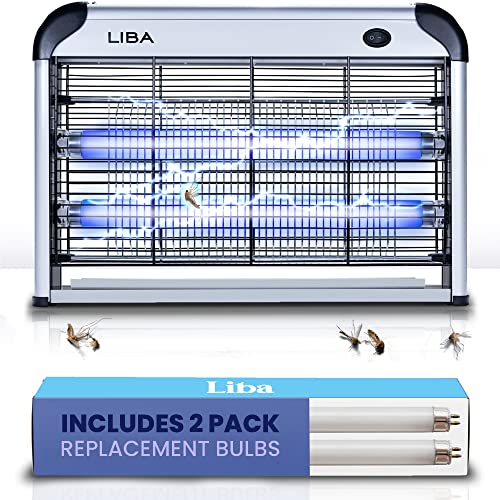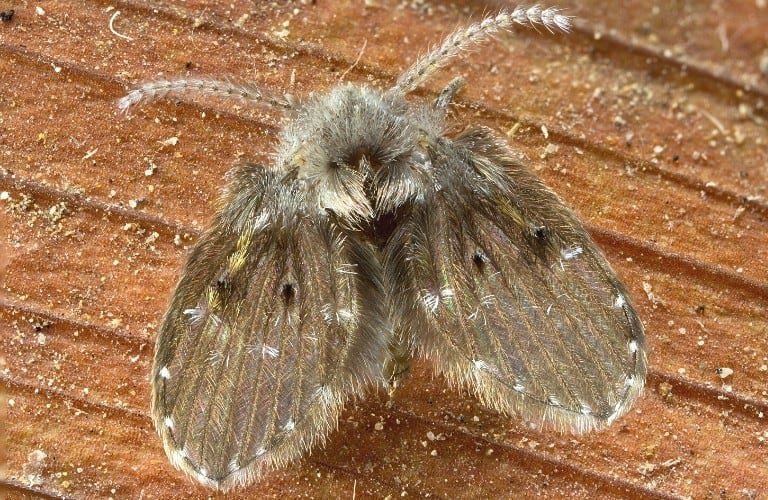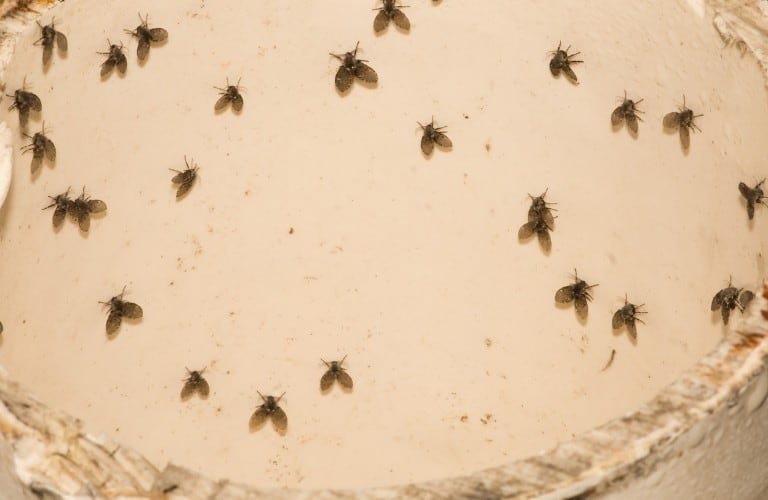Small bugs that fly out of your sink and shower drains are unattractive and annoying.
If you’re looking for a nonchemical way to get rid of these bugs, there are a variety of traps that will do the trick.
What is the best trap for drain flies? When trying to get rid of drain flies, the best option is a UV light trap that lures the drain flies in with light. Bug zappers designed for indoor use will eliminate drain flies as well. For a nonelectric option, sticky glue traps can be effective.
The first step in eliminating drain flies is to be sure that you’re correctly identifying the pest.
After selecting an appropriate trap, you’ll begin seeing fewer and fewer annoying bugs coming from your drains.
Then, you can initiate preventative measures to ensure that the problem won’t reoccur.
In the following, you’ll learn each step of the elimination process and see which traps will be the best choice for your situation.
Best Practices for Preventing an Infestation
Drain flies are small, making them difficult to identify. Additionally, they look similar to many other types of tiny bugs.
Look for the following clues to determine whether you’re fighting a drain fly infestation or some other type of bug.
The Drain Fly
Drain flies, technically named Psychodidae, are also known as moth flies, sink flies, or sewer gnats.
They are small bugs around the same size as gnats, between 2 and 5 millimeters long. In fact, they are one of the specific types of bugs included in the group generally known as “gnats.”
Because they are insects, they have six legs and antennae, in addition to two wings.
These bugs have dark, scaly wings that become a sticky powder when smashed. Their bodies are short and hairy, adding to their resemblance to moths.
Drain flies are typically paler gray than other gnats and do not fly as far as fruit flies or fungus gnats, though they can be easily confused with both, especially fruit flies.
(See how different they actually are in this article.)
Life Cycle, Diet, and Habits
Most drain flies live in drainage or sewer systems where they are considered a nuisance.
They do not bite or carry disease but are unattractive and can be invasive if left out of control.
Drain flies typically only live somewhere between eight and 24 days, but they have an incredibly short reproduction period.
Female drain flies lay and hatch 300 offspring every 48 hours!
This makes it very difficult to fight an infestation, as they can multiply before you even know they are there. They can quickly overtake your plumbing and become an infestation.
Larvae are pale, flattened cylinders with a black head. They are often found just inside drains or under toilet bowl rims.
A key indicator of drain flies is a short, erratic, jumpy type of flying. It looks more like they are hopping instead of flying.
Drain flies feed on organic material and waste that can commonly be found in your plumbing system. This includes food remnants, animal or human waste, and garbage.
This is why these bugs prefer to live in pipes and sewage systems. They need a combination of plenty of moisture and a little organic material.
(See our article “What Causes Drain Flies?” for more information.)
Because their life cycles are so short, they do not eat much, allowing large congregations to live on small amounts of organic material.
You might also find drain flies around compost piles, garbage, and fecal matter.
Machines that tend to contain stagnant water like carpet cleaners or sump pumps can become hosts for drain flies as well. We show you how to deal with sump pump infestations here.
Quick Tip
If you believe you have drain flies, try covering the drain with duct tape for a few days.
The drain flies will try to fly out of the drain and will get caught on the tape, showing you whether or not there is an infestation.
Basic Guidelines
Since drain flies reproduce so quickly and at such high numbers, it is important to prevent them from infesting from the beginning.
Unfortunately, this is difficult because by the time you notice an adult drain fly, they have likely already laid hundreds of eggs.
So when seeking to prevent drain flies, there are a couple of tactics.
Unclog Drains
Clogged or slow drains give drain flies the perfect breeding ground for their eggs. They prefer the slimy buildup of dirt and grime in drain traps and pipes.
As soon as you notice a clogged or slow drain in your home, be quick to use some sort of declogging solution before drain flies can lay their eggs.
The declogging product will not kill eggs or larvae that have already been laid but can help prevent adults from making their home in the standing water.
Green Gobbler Drain Clog Dissolver powers through tough clogs but doesn’t contain any harsh chemicals or strong odors.
The thick gel liquefies organic material standing in the way of free-flowing drains and is guaranteed to work. As an added bonus, five plastic hair grabbers are included.
Clean Bathrooms and Kitchens Often
Drain flies use their impeccable senses and instincts to detect small amounts of organic material.
If the basin of your sink, toilet, or shower contains any waste, they will find it and make their way down the drain.
Use a sanitizing product to frequently clean all elements of your bathroom.
Pay particular attention to toilets, as the waste deposited in toilets is Psychodidae’s preferred food. Always flush toilets after using them.
Drain flies may sometimes infest the toilet tank or bowl but are more likely to choose a less accessible part of the toilet, and complete disassembly may be required.
Don’t panic. This guide explains how to treat toilet infestations should they occur.
Dry up any water that does not make it down the sink or shower drain, as this moisture attracts drain flies.
Always run the garbage disposal as soon as you put leftover food down the drain.
Safely pour extremely hot water down drains when cleaning the bathroom or kitchen, as the steam and heat are often enough to kill bacteria and hopefully any drain fly larvae.
Make sure any garbage containers are emptied regularly and any leakage is cleaned up quickly with a disinfectant.
Use a Larva Killing Pesticide
Even if you kill all the adult drain flies within a couple of days, you still must get rid of the larvae. Ignoring this part of the problem will let the infestation grow.
Look for a product that is intended to be poured down drains, as some pesticides contain corrosive chemicals that will damage pipes.
Natural Armor Fruit & Drain Fly Killer is a great option that coats the inside of pipes, killing all larvae present.
Note that these products will not necessarily kill adult drain flies, which is why traps are important.
For more information on drain flies and additional tips for getting rid of them for good, check with our lineup of drain fly articles. Click here to see them all.
Drain Fly Traps – What to Look For
There are three main types of traps for drain flies: UV light traps, sticky glue traps, and zappers. The good news is that all of these traps will catch and kill any type of gnat, not just drain flies.
Even if you are unsure of whether or not that bug is a drain fly, it will be killed by any of these options.
Keep in mind that prevention methods should be practiced in conjunction with the use of traps and should continue after the problem is resolved to prevent another infestation.
Our article “How To Get Rid of Drain Flies” is an excellent resource for prevention techniques.
Types of Drain Fly Traps
UV Light Traps
UV light traps work by attracting drain flies and other small, flying bugs with a gentle blue light.
These bugs, once attracted, get stuck to a sticky paper at the base of the canister.
Some of these traps utilize a gentle fan to suck drain flies in once they come close enough.
These traps work well in general but are most effective at night when the light is brightest.
During the daytime, the blue light blends in with the daylight, and the gnats are not as attracted to the trap.
They are also chemical free, which is attractive to anyone with allergies or a sensitivity to chemicals.
Additionally, these traps run on electricity. This means that they have to be placed near enough to an outlet for the cord to reach.
This form of trap is more attractive than some others since the dead carcasses of the drain flies are hidden from sight.
The sticky glue in these traps will need to be replaced frequently, so keep that in mind when considering the overall expense.
These are widely considered to be the safest drain fly traps on the market, as the glue sheets are protected and there is no dangerous mechanism.
Sticky Glue Traps
These drain fly traps are simple and easy to use, even if they are unattractive.
For drain flies, these traps are often yellow rectangles made out of PVC or strong paper material. The yellow color plays to the drain flies’ phototaxis, or attraction to light.
Compared to UV light traps, these traps are cost-efficient and simple.
However, they do not always work as well as the UV lights, since the only thing attracting them is the yellow color, which only mimics light.
They are often sold with a string of some sort so that you can hang them around the home.
Another type of sticky glue traps is designed to look like 3D fruit, like apples or tomatoes.
Though there is no scientific evidence for why this shape attracts gnats, the traps are filled with a food-based liquid that lures the bugs into the trap.
Once the drain flies are inside, they cannot escape and will eventually drown.
Ribbon traps come in cardboard tubes. You then pull the ribbon out of the tube, and it remains in a spiral shape with glue on both sides.
Then, you hang the ribbon in the areas where drain flies most frequently congregate.
Preferably, the ribbon should be hung in an area with plenty of light, since drain flies (and most other bugs) will be attracted to that area.
Look for ribbons that come with a scent that attracts drain flies and other bugs. This is their only way to attract bugs.
This makes them less effective than other types of traps like UV light traps. However, they are cost-efficient and easy to use.
Keep all forms of sticky glue traps out of the reach of children and pets. The rectangular traps are incredibly sticky and will attach to anything they touch.
The food-based liquid in the 3D traps is hazardous and should not be consumed by humans or animals.
Bug Zappers
Bug zappers are electrified devices that burn or “zap” bugs when they land on them. Like UV light traps, zappers emit soft blue light to attract drain flies and other bugs.
You can find these zappers in several forms and intensities depending upon your needs.
Some are small and fit into a plugin like an air freshener or night light. Others are bigger, hanging on hooks or nails from the ceiling or wall.
Look for a zapper that is noiseless and odorless, since some zappers have an audible burning noise and smell when bugs are killed.
Also, look for zappers that have a sturdy tray into which dead drain flies can fall. Otherwise, they will land on the ground, forcing you to clean them up frequently.
If you have young children or pets in the home, make sure to place the bug zapper out of their reach.
Though most zappers have a grate in front of the zapping mechanism, children or pets may still be able to fit body parts through it.
Effectiveness
Before deciding on a which trap is best for your situation, carefully consider the area you will most likely be placing the trap and which form of trap will best suit your needs.
For example, if you have a large kitchen, small sticky traps may not be as effective as a UV light trap, but the sticky traps may work quite well in a small bathroom.
Read all packaging carefully to ensure that the product will be effective in the room you’ll be using it.
Safe for Use Around People and Pets
Safety, even with products as seemingly harmless as traps, should always be a priority.
Read all warning labels, and perhaps steer clear of any traps with exposed or easily accessible glue pads if there are small children or curious pets in the home.
Selecting traps that can easily be placed well out of the reach of kids and animals is often ideal.
Ease of Use
Most traps targeting drain flies are extremely easy to use and are usually designed to be put in place and forgotten for a while.
The glue pads in UV light traps and sticky-type traps will need to be removed and replaced often.
The bugs that have succumbed to bug zappers will need to cleaned up either by dumping the collection tray or sweeping them up from underneath the unit.
Consider which clean up you’ll be most comfortable with: replacing glue pads or dumping dried-out, dead bugs.
Best UV Light Traps
Eon Luxe Solutions
This is a top-of-the-line UV light trap that works well for mosquitoes, gnats, and drain flies. It is relatively portable, attractive, and can be placed anywhere around the house.
The Eon Luxe uses UV light, a fan, and glue pads to attract drain flies. The light first attracts the drain flies, and the fan then sucks them inside where they become trapped in the glue.
It comes with six sticky pads, which last up to six months in the winter.
Pros:
- Plenty of sticky glue pads.
- Attractive canister.
- Very quiet motor.
- No odor, no chemicals, and no zapping noises.
Cons:
- The glue trap is visible at the bottom of the canister, which is unattractive.
KATCHY Indoor Insect and Flying Bug Trap
This UV light device uses a pretty purple light and super sticky glue to trap bugs. One benefit of the KATCHY trap is that it can handle bigger bugs than many other UV traps.
Due to its stylish, sleek design, visitors may mistake it as part of your decor and never realize that it is a bug killing device.
Pros:
- Can handle moths and mosquitoes.
- Powerful UV light and fan.
Cons:
- Comes with fewer sticky glue traps.
- Dead bugs are visible.
Best Sticky Glue Traps
Kensizer Dual-Sided Yellow Sticky Traps
These are the best rectangular sticky glue traps on the market. Cheap and easy to use, these boards work well for indoor and outdoor gnat infestations.
They will trap any type of flying bug, using the bug’s phototaxis to attract it to the yellow color.
Pros:
- Simple and easy to use.
- Cost-efficient.
Cons:
- Unattractive when full of dead bugs.
- Aren’t a powerful source of attraction for drain flies.
Raid Fruit Fly Trap
These apple-shaped traps are meant for fruit flies (another type of gnat), but they use a food-based lure that will also attract drain flies.
All you have to do is add water to activate the scent. Once the gnats are attracted into the trap, they cannot get out and will eventually drown.
Pros:
- Dead bugs are hidden inside the trap, not out in the open.
- Fit in well with a kitchen aesthetic.
- Easy to use and reusable.
Cons:
- Only use scent to attract drain flies.
- Not as powerful as some other types of traps.
Catchmaster Sticky Fly Tape Ribbon
This is a durable, long-lasting ribbon with sticky glue. It fastens easily to windows, cabinets, or walls.
Its super strong glue will last the entire season without needing to be replaced.
Pros:
- Simple and cost efficient.
- Has a scent to attract drain flies and other gnats.
- Made out of nontoxic glue.
Cons:
- Scent is unattractive and overwhelming to humans.
- Better for bathrooms than kitchens, as the paper ribbons are unattractive.
Best Bug Zappers
Klahaite Bug Zapper
This powerful bug zapper is safe for all areas of the home (as well as outdoors) and is designed with narrow gabs to reduce the chance of kids or pets being shocked.
The removal collection tray makes getting rid of the dead bugs easy.
Pros:
- No scent to attract bugs.
- Safe for indoor and outdoor use.
Cons:
- Motor is louder than other options.
LiBa Bug Zapper Electric Indoor Insect Killer
This is a powerful bug zapper that kills all types of flying insects. It conveniently catches bugs in a tray at the bottom.
This large zapper (10.5 by 15 inches) is ideal for restaurants, greenhouses, or outdoor kitchens, so it will definitely be enough to handle a small issue like drain flies in an ordinary home environment.
Pros:
- Attracts bugs with a powerful UV light.
- Covers an area of up to 6,000 square feet.
Cons:
- Requires electricity.
- Makes a burning sound each time a bug is killed.
ASPECTEK Bug Zapper
This is a powerful bug zapper that works quickly. It is safe for all areas of the home (including outdoors) and can be placed on a level surface or hung from a wall or hook. Its alternating metal grates make it near-impossible for kids or pets to be shocked. It targets flies, moths, mosquitos, and wasps.
The washable removal collection tray makes getting rid of dead bugs easy.
This model is more expensive than the LiBa zapper listed above, but is more powerful as well.
Pros:
- Quiet operation when bugs are killed.
- Safer than other zappers for use around kids and pets.
- Powerful double-bulb setup immediately kills any drain fly.
Cons:
- Stronger zapper requires more electricity than other models.
Summary
When fighting a drain fly infestation, consider purchasing a UV light trap, sticky glue traps, or a bug zapper.
These products, in addition to preventative measures like eliminating standing water and organic material in bathrooms and kitchens, can help you take control of the drain fly infestation in your home.













